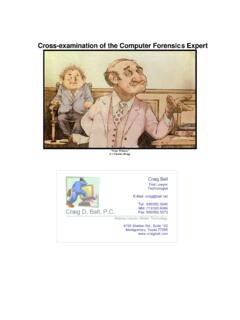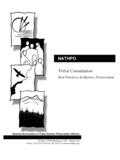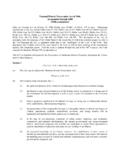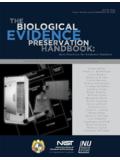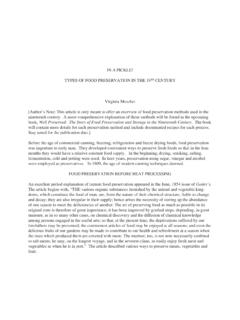Transcription of perfect preservation letter - Craig Ball
1 Craig Ball The perfect preservation letter The perfect preservation letter By Craig Ball Well, I was drunk the day my Mom got outta prison, And I went to pick her up in the rain;. But before I could get to the station in my pickup truck, She got runned over by a damned old train. From You Never Even Called Me By My Name . (a/k/a The perfect Country and Western Song ). By Steve Goodman, performed by David Allan Coe Outlaw musician David Allan Coe sings of how no country and western song can be perfect . unless it talks of Mama, trains, trucks, prison and getting drunk. Likewise, no digital evidence preservation letter can be perfect unless it clearly identifies the materials requiring protection, educates your opponent about preservation options and lays out the consequences of failing to preserve the evidence. You won't find the perfect preservation letter in any formbook.
2 You have to build it, custom-crafted from a judicious mix of technical boilerplate and fact-specific direction. It compels broad retention while appearing to ask for no more than the bare essentials. It rings with reasonableness. It keeps the focus of e-discovery where it belongs: relevance. This article discusses features of the perfect preservation letter and offers suggestions as to how it can be effectively drafted and deployed. Contents The Role of the preservation The Proposed Amendments to the Rules of Civil What is Electronic Evidence preservation ? ..3. Touching Data Changes It ..3. Digital Evidence Is Increasingly Ill-Suited to Printing ..4. Data Must Be Interpreted To Be Used ..4. Storage Media Are Fragile and Changing ..4. Digital Storage Media Are Dynamic and The Duty to Balance and Reasonableness ..5. preservation Essentials.
3 6. The Nature of the Case ..6. When to Send a preservation Who Gets the letter ? ..7. How Many preservation Letters?..8. Specifying Form of Special Cases: Back Up Tapes, Computer Forensics and Metadata ..8. Back Up Tapes ..9. Drive Cloning and Metadata ..11. End Game ..12. APPENDIX: Exemplar preservation Demand to Opponent ..13. 2006 All Rights Reserved 1. Craig Ball The perfect preservation letter The Role of the preservation letter The reality of electronic discovery is it starts off as the responsibility of those who don't understand the technology and ends up as the responsibility of those who don't understand the law.. You can read the Federal Rules of Civil Procedure from cover to cover and not see a reference to preservation letters. So why invest a lot of effort creating the perfect preservation letter ? Wouldn't it be sufficient to remind your opponent that the laws and rules prohibiting destruction of evidence apply to electronically stored information in the same manner that they apply to other evidence and that they must take every reasonable step to preserve this information until the final resolution of the case?
4 Perhaps in a decade or so it will be enough; but, today we face an explosion of electronic evidence untamed by sound records management. Too many litigators and in-house counsel are clueless about information systems. The reality of electronic discovery is it starts off as the responsibility of those who don't understand the technology and ends up as the responsibility of those who don't understand the law. A well-drafted preservation letter helps bridge this knowledge gap. The goal of the preservation letter is, of course, to remind opponents to preserve evidence, to be sure the evidence doesn't disappear. But, the preservation letter also serves as the linchpin of a subsequent claim for spoliation, helping to establish bad faith and conscious disregard of the duty to preserve relevant evidence. It is today's clarion call that underpins tomorrow's, I.
5 Told you so. The more effectively you give notice and convey what must be retained--including methodologies for preservation and consequences of failure--the greater the likelihood your opponent will be punished for destruction of evidence. The Proposed Amendments to the Rules of Civil Procedure Though serving a preservation letter isn't a formal component of civil discovery procedures, it's likely to be a de facto practice as federal and local rules of civil procedure impose express e- discovery meet and confer obligations upon litigants. For example, effective December 1, 2006, Rule 26 of the Federal Rules of Civil Procedure will require litigants to discuss any issues relating to preserving discoverable information, 1 as well as any issues relating to disclosure or discovery of electronically stored information, including the form or forms in which it should be 2 The preservation letter is sure to frame the agenda for such discussions.
6 The preservation letter will may play an important role in a court's consideration of whether a party acted in good faith in connection with information lost to routine operations of an electronic information Assessment of good faith turns on the subjective awareness of the party 1. Proposed Amendment to Rule 26(f) of the Federal Rules of Civil Procedure. All proposed Amendments and commentary cited are available at 2. Id. Rule 26(f)(3). 3. Id. Proposed Rule 37(f), entitled Electronically Stored Information provides, Absent exceptional circumstances, a court may not impose sanctions under these rules on a party for failing to provide electronically stored information lost as a result of the routine, good-faith operation of an electronic information system.. 2006 All Rights Reserved 2. Craig Ball The perfect preservation letter failing to preserve evidence.
7 The preservation letter can establish such awareness, bolstering a claim that the party destroying evidence knew of its discoverability and recklessly or intentionally disregarded it. Per commentary to the proposed rule, Good faith in the routine operation of an information system may involve a party's intervention to modify or suspend certain features of that routine operation to prevent the loss of information, if that information is subject to a preservation obligation. 4 A clear and instructive preservation letter that serves to educate your opponent isn't just a professional courtesy; it also compels recognition of a duty to intervene to prevent data loss and deprives an opponent of a sanctions safe harbor.. A clear and instructive preservation letter that serves to educate your opponent isn't just a professional courtesy.
8 What is Electronic Evidence preservation ? When evidence is a paper document, preserving it is simple: We set the original or a copy aside, confident that it will come out of storage exactly as it went in. Absent destructive forces or tampering, paper stays pretty much the same. But despite lawyers' ardor for paper, 95% of information is born digitally, and the overwhelming majority is never printed. By contrast, preserving electronic data poses unique challenges because: Touching data changes it Digital evidence is increasingly ill-suited to printing Data must be interpreted to be used Storage media are fragile and changing all the time Digital storage media are dynamic and recyclable Touching Data Changes It Route a document through a dozen hands and, aside from a little finger grime or odd coffee stain, the document won't spontaneously change just by moving, copying or reading it.
9 But open that same document in Microsoft Word, or copy it to a CD, and you've irretrievably changed that document's system metadata, the data-about-data items, like the document's creation or last access dates that may themselves be evidence. It's common to use recordable CDs to transfer data between systems or as a medium of e- production. But how many lawyers are aware that you can't easily copy all of a file's metadata when it's moved from hard drive to a recordable CD? The two media use different file systems such that the CD-R doesn't offer a structure capable of storing all of a file's Windows metadata. That is, where the Windows file system offers three slots for storing file dates ( , Modified, Accessed and Created), the CD-R file structure has but one. With no place to go, metadata is jettisoned in the CD recording process, and the missing metadata may be misreported on the destination system.
10 4. Id. Committee Note to Proposed Rule 37(f). 2006 All Rights Reserved 3. Craig Ball The perfect preservation letter Digital Evidence Is Increasingly Ill-Suited to Printing Much modern evidence doesn't lend itself to paper. For example, a spreadsheet displays values derived from embedded formulae, but you can't embed those formulae in paper. In large databases, information occupies expansive grids that wouldn't fit on a printed page or make much sense if it could. And, of course, sound and video evidence can't make the leap to paper. So preserving on paper isn't always an option, and it's rarely an inexpensive or efficient proposition. Data Must Be Interpreted To Be Used If legible and in a familiar language, a paper document conveys information directly to the reader. A literate person can interpret an alphabet, aided by blank space and a few punctuation marks.

![Musings on Meet and Confer[1] - Craig Ball](/cache/preview/1/d/f/4/3/6/b/f/thumb-1df436bf3ad0de7eda6169531df27533.jpg)
